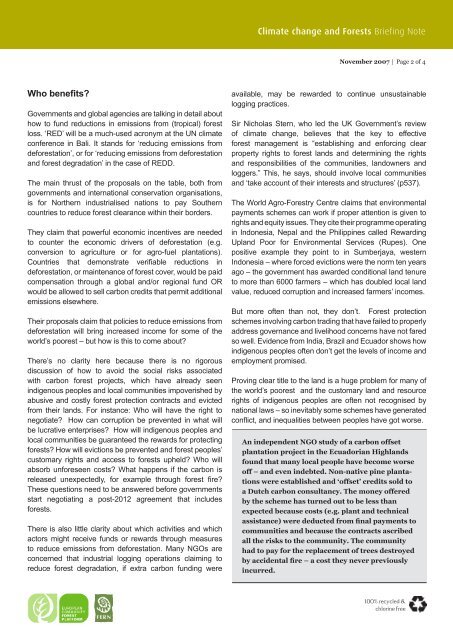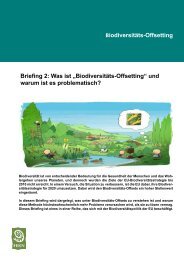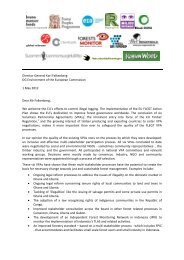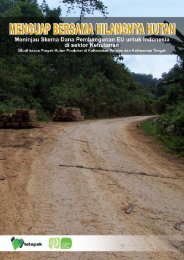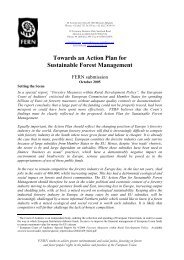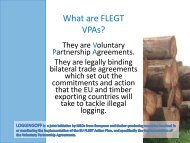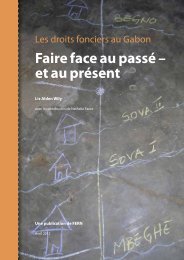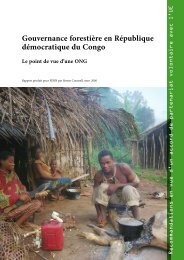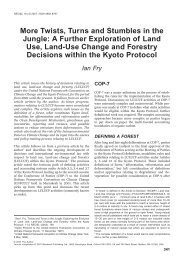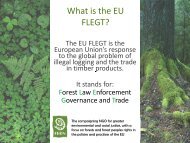OPEN - Fern
OPEN - Fern
OPEN - Fern
Create successful ePaper yourself
Turn your PDF publications into a flip-book with our unique Google optimized e-Paper software.
Who benefits?<br />
Governments and global agencies are talking in detail about<br />
how to fund reductions in emissions from (tropical) forest<br />
loss. ‘RED’ will be a much-used acronym at the UN climate<br />
conference in Bali. It stands for ‘reducing emissions from<br />
deforestation’, or for ‘reducing emissions from deforestation<br />
and forest degradation’ in the case of REDD.<br />
The main thrust of the proposals on the table, both from<br />
governments and international conservation organisations,<br />
is for Northern industrialised nations to pay Southern<br />
countries to reduce forest clearance within their borders.<br />
They claim that powerful economic incentives are needed<br />
to counter the economic drivers of deforestation (e.g.<br />
conversion to agriculture or for agro-fuel plantations).<br />
Countries that demonstrate verifiable reductions in<br />
deforestation, or maintenance of forest cover, would be paid<br />
compensation through a global and/or regional fund OR<br />
would be allowed to sell carbon credits that permit additional<br />
emissions elsewhere.<br />
Their proposals claim that policies to reduce emissions from<br />
deforestation will bring increased income for some of the<br />
world’s poorest – but how is this to come about?<br />
There’s no clarity here because there is no rigorous<br />
discussion of how to avoid the social risks associated<br />
with carbon forest projects, which have already seen<br />
indigenous peoples and local communities impoverished by<br />
abusive and costly forest protection contracts and evicted<br />
from their lands. For instance: Who will have the right to<br />
negotiate? How can corruption be prevented in what will<br />
be lucrative enterprises? How will indigenous peoples and<br />
local communities be guaranteed the rewards for protecting<br />
forests? How will evictions be prevented and forest peoples’<br />
customary rights and access to forests upheld? Who will<br />
absorb unforeseen costs? What happens if the carbon is<br />
released unexpectedly, for example through forest fire?<br />
These questions need to be answered before governments<br />
start negotiating a post-2012 agreement that includes<br />
forests.<br />
There is also little clarity about which activities and which<br />
actors might receive funds or rewards through measures<br />
to reduce emissions from deforestation. Many NGOs are<br />
concerned that industrial logging operations claiming to<br />
reduce forest degradation, if extra carbon funding were<br />
November 2007 | Page of 4<br />
available, may be rewarded to continue unsustainable<br />
logging practices.<br />
Sir Nicholas Stern, who led the UK Government’s review<br />
of climate change, believes that the key to effective<br />
forest management is “establishing and enforcing clear<br />
property rights to forest lands and determining the rights<br />
and responsibilities of the communities, landowners and<br />
loggers.” This, he says, should involve local communities<br />
and ‘take account of their interests and structures’ (p537).<br />
The World Agro-Forestry Centre claims that environmental<br />
payments schemes can work if proper attention is given to<br />
rights and equity issues. They cite their programme operating<br />
in Indonesia, Nepal and the Philippines called Rewarding<br />
Upland Poor for Environmental Services (Rupes). One<br />
positive example they point to in Sumberjaya, western<br />
Indonesia – where forced evictions were the norm ten years<br />
ago – the government has awarded conditional land tenure<br />
to more than 6000 farmers – which has doubled local land<br />
value, reduced corruption and increased farmers’ incomes.<br />
But more often than not, they don’t. Forest protection<br />
schemes involving carbon trading that have failed to properly<br />
address governance and livelihood concerns have not fared<br />
so well. Evidence from India, Brazil and Ecuador shows how<br />
indigenous peoples often don’t get the levels of income and<br />
employment promised.<br />
Proving clear title to the land is a huge problem for many of<br />
the world’s poorest and the customary land and resource<br />
rights of indigenous peoples are often not recognised by<br />
national laws – so inevitably some schemes have generated<br />
conflict, and inequalities between peoples have got worse.<br />
An independent NGO study of a carbon offset<br />
plantation project in the Ecuadorian Highlands<br />
found that many local people have become worse<br />
off – and even indebted. Non-native pine plantations<br />
were established and ‘offset’ credits sold to<br />
a Dutch carbon consultancy. The money offered<br />
by the scheme has turned out to be less than<br />
expected because costs (e.g. plant and technical<br />
assistance) were deducted from final payments to<br />
communities and because the contracts ascribed<br />
all the risks to the community. The community<br />
had to pay for the replacement of trees destroyed<br />
by accidental fire – a cost they never previously<br />
incurred.


